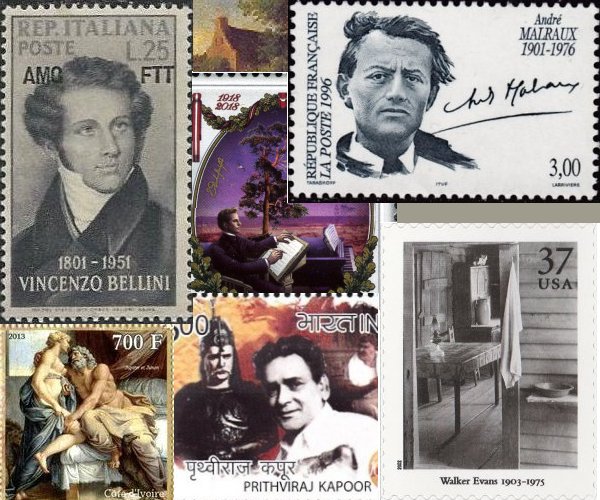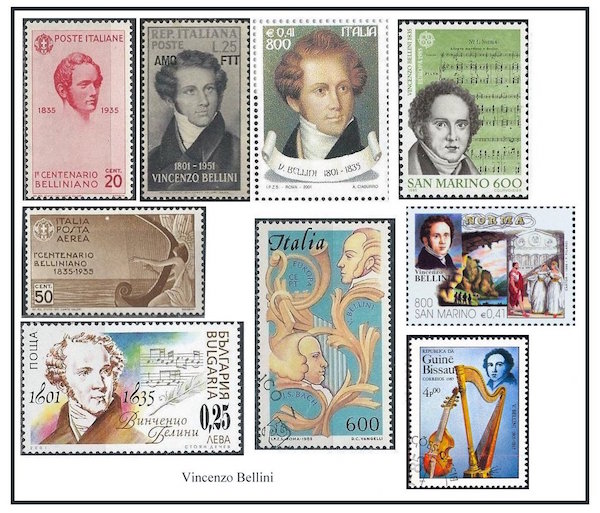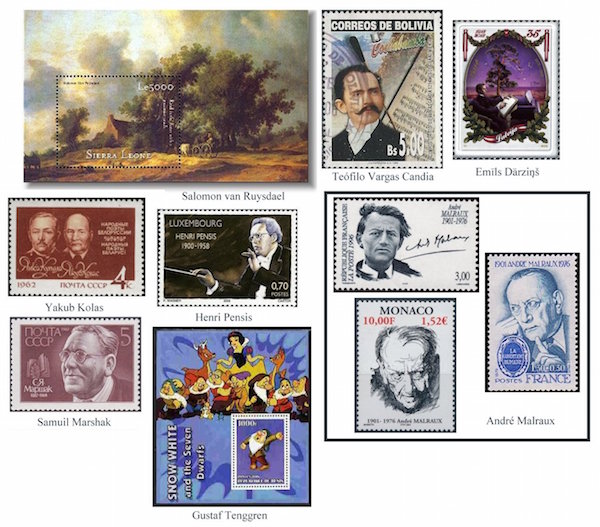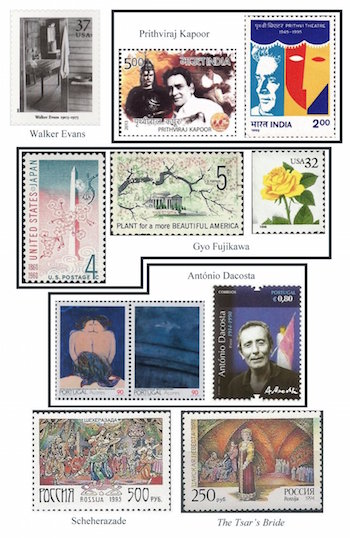The Arts on Stamps of the World — November 3
An Arts Fuse regular feature: the arts on stamps of the world.

By Doug Briscoe
Today we acknowledge the birthdays of composer Vincenzo Bellini, painter Annibale Carracci, and writer André Malraux, among others.
The short-lived Italian opera composer Vincenzo Bellini (3 November 1801 – 23 September 1835) was a master of bel canto, fervently admired by Chopin and Verdi and even by such “music of the future” composers as Liszt and Wagner. Bellini was a child prodigy from Catania, the eldest of seven children in a very musical family. He produced ten operas—La sonnambula, Norma, and I Puritani the most frequently presented—before his early death, attributed to an acute inflammation of the colon.

Annibale Carracci (November 3, 1560 – July 15, 1609) came of a family of Bolognese painters, including his brother Agostino and his cousin Ludovico, whose work we’ve already seen in these pages. Today’s collage offers two sheets and four individual stamps. The background of the sheet from Côte d’Ivoire uses Landscape with the Flight into Egypt (c1603), a detail of which is on a stamp from Palau placed at upper left. Next to it is a detail from Venus, Adonis, and Cupid (c1595), from which Adonis has been excised. The stamps on the sheet are of The Choice of Heracles (1596) and Jupiter and Juno from Carracci’s huge fresco cycle The Loves of the Gods (1597). The sheet from Madagascar gives us St Roch and the Angel, The Beaneater (1580-90), and Venus with a Satyr and Cupids (c1588). On the pink-bordered Easter stamp from Jamaica is Lord, Whither Goest Thou? (1601-02), and we wind up with a Togolese issue showing Lamentation of Christ (1606).
An artist of the next century was Salomon van Ruysdael, born about 1602 and buried on this date in 1670. Again his was a painterly family, his nephew being the more renowned Jacob van Ruisdael (choose whichever spelling you like). Salomon had also a brother named Jacob (or Isaak—sources differ), and both were landscape painters, though Salomon also made sculpted ornaments resembling marble fixtures. Salomon was a member of the Haarlem Guild of St. Luke from 1623. I was able to find only one of his works on a stamp (a minisheet, actually), Road in the Dunes with a Passenger Coach (1631), but I want you to give your money’s worth, so here, too, are River Mouth with Fortified City (1648) and View of Deventer Seen from the North-West (1657).
Bolivian composer Teófilo Vargas Candia (1866–1961) established a school of music in his home in Cochabamba, where he taught free of charge. This eventually grew into the Cochabamba Musical Conservatory, which was renamed for him after he died. He wrote mostly lighter pieces and songs, but also some sacred music, symphonic poems, marches, a Hymn to Cochabamba (1901), and a zarzuela for children, The Black Castle (1902). His manuscripts were transcribed and published in two volumes in 2013.
Latvian composer Emīls Dārziņš (1875 – August 31, 1910) led a troubled life. He nearly lost his eyesight from straining to read; this was at the age of 3! He was found to have an allergy to sunlight and lived in a darkened room for the next five years. His parents were musically inclined, and he attended the Moscow Conservatory, but had to abandon his studies because of an unspecified illness. His compositions were fiercely attacked by other Latvian composers, and Dārziņš was bold enough to seek an impartial judgement from no less a figure than Alexander Glazunov, who dismissed the criticisms, although Sibelius had shared the opinion of the decriers. Dārziņš destroyed all his orchestral scores (only his Melancholy Waltz could be posthumously reconstructed) and turned to alcoholism. His death at 34 under the wheels of a train may have been a suicide. His surviving works are mostly choruses and songs, and he left an unfinished opera. His son Volfgangs Dārziņš (1906–1962), named in honor of Mozart, was also a composer, pianist, and music critic. The stamp for Emīls came out in 2012.

We have today two writers born into the Imperial Russian Empire. First the Belarusian Yakub Kolas (November 3 [O.S. October 22] 1882 – August 13, 1956), primarily a poet who also wrote stories and plays. His real name was Kanstancin Mickievic, and he adopted the pseudonym Kolas, meaning “ear of grain”, as a token of his sympathy for the peasantry. His earlier collections were titled Songs of Captivity (1908) and Songs of Grief (1910). He was named People’s Poet of the Byelorussian SSR in 1926 and later served as vice-president of the Belarusian Academy of Sciences. Born in the district of Minsk, he died in the city of that name, where a square and a street named for him can be found.
The other writer, five years younger, was Samuil Marshak (3 November [O.S. 22 October] 1887 – 4 July 1964). He was especially known for his Shakespeare translations—his versions of the sonnets being particularly admired—and children’s stories and poems. Born into a Jewish family in Voronezh, he began writing poetry as a child. When the family moved to Saint Petersburg, that is, outside the Pale of Settlement, where Jews were disallowed from taking permanent residence, Samuil could not legally attend school until the influential and powerful critic Vladimir Stasov, impressed with the boy’s gifts, arranged to have him admitted. Beyond that, Stasov introduced him to Maxim Gorky and Feodor Chaliapin, both of whom would prove to be Marshak’s benefactors. They paid for his education, and when Marshak fell ill with tuberculosis in 1904, Gorky found a place in Yalta for the young writer to live. In that same year, Marshak’s first published work appeared in the magazine Jewish Life. He went to England in 1912 to study philosophy and fell in love with English poetry, promptly preparing translations of Blake, Robert Burns, and Wordsworth. These were published in Russia. His interest in children’s literature developed a bit later. His little daughter died in 1915, and in 1920 he was placed in charge of orphanages in Ekaterinodar province. There he was instrumental in helping create a Children’s Town that included a theater, for which he wrote plays, a library, and studios. His translation of Shakespeare’s sonnets appeared in 1948, and many song settings by composers such as Dmitry Kabalevsky followed. Marshak’s siblings Ilya (1896-1953) and Liya (1901-1964) were also Soviet authors. (Another children’s author, Gyo Fujikawa, is featured below.)
Gustaf Tenggren (November 3, 1896 – April 9, 1970) was one of Disney Studios’ chief illustrators from the 1930s. Born in Sweden, he came to America in 1920, at first joining his sister in Cleveland before moving on to New York in 1922. By the next year he was working as a children’s book illustrator. Walt Disney Productions hired him in 1936, and he had a leading hand in such films as Snow White and the Seven Dwarfs, Fantasia, Bambi, and Pinocchio. Of the multitude of Disney stamps from around the world I selected a Snow White minisheet from Benin.
Henri Pensis (1900 – 1 June 1958) founded the Luxembourg Philharmonic Orchestra in 1933 and conducted the orchestra until he moved to the US in 1940. Here he was conductor of the New Jersey Philharmonic and the Sioux City Symphony during the war. He also composed some orchestral pieces, a few popular songs, and a musical called Nockes an Nackes. The stamp was issued by Luxembourg in 2008 for the fiftieth anniversary of Pensis’s death.

The first published piece by André Malraux (3 November 1901 – 23 November 1976) was an article entitled “The Origins of Cubist Poetry”, then he wrote three semi-surrealist tales, one of which had illustrations by Fernand Léger. All of this gives a pretty clear indication that Malraux was no reactionary. Two figures who made strong impressions on the young man were Nietzsche and T.E. Lawrence, whose adventures were perhaps responsible for Malraux’s journey to the east in 1923. This trip resulted in his first published book, The Temptation of the West (1926), an epistolary dialogue between a Westerner and an Asian. Then came Malraux’s first novel, The Conquerors (1928). He joined the Republican forces at the start of the Spanish Civil War and the French Army at the outset of World War II. He was made a prisoner, escaped, joined the Resistance and was captured again, this time by the Gestapo, and this time was rescued by his colleagues, going on to command a tank. Malraux’s political life began right after the war, when de Gaulle made him Minister for Information. Years later (1958), as president, de Gaulle appointed him Minister of Cultural Affairs, which post Malraux retained until 1969. Malraux, who wrote extensively about art, created a program to refresh the darkened façades of historic buildings in France. In 1967 he produced Antimémoires, the first of his semi-autobiographical works. I started to read it once but found its early pages unassimilable and gave up.
American photojournalist Walker Evans (November 3, 1903 – April 10, 1975) was born in St. Louis, Missouri in well-to-do circumstances. He was a graduate of Phillips Academy in 1922 and spent a year in Paris in 1926. On his return he hobnobbed with the literary elite—John Cheever, Hart Crane, Lincoln Kirstein, and their ilk. He turned to photography in the year 1928 and a few years later came to Boston to photograph Victorian houses for Kirstein. Another assignment in 1933 took him to Cuba, where he got chummy with Ernest Hemingway. Later still Evans did his most celebrated work for the Farm Security Administration (FSA). He and James Agee traveled to Alabama to report on the effects of the Depression there, and their work appeared in 1941 in the seminal photo book Let Us Now Praise Famous Men. The most famous, probably, of the photos in that book is one of sharecropper Allie Mae Burroughs. Another picture is shown on the 2001 stamp. Evans also worked as a staff writer for Time magazine and an editor for Fortune. By the way, on leaving Cuba, Evans was apprehensive that his photos might be confiscated, so he left some negatives with Papa Hemingway. These were rediscovered in Havana in 2002.
Speaking of film, we come next to the patriarch of a prominent family in the Hindi film industry, Prithviraj Kapoor (3 November 1906 – 29 May 1972). Born in the Punjab, Kapoor acted on the stage in Peshawar and elsewhere before moving to Bombay in 1928 and joining the Imperial Films Company as an extra. He acted in nine silents and a series of talkies, often in leading parts, before starring in the title role of Sikandar (1941), directed by Sohrab Modi (whose birthday we celebrated just yesterday). This is probably Kapoor’s best known movie performance. But all the while Kapoor continued to devote much of his energy to the stage. In 1942, he founded his own theater group, Prithvi Theatres, the fiftieth anniversary of which was acknowledged on an Indian stamp. The group put on 2,662 performances in sixteen years, and Kapoor starred in every…single…one. After Kapoor went into semi-retirement he would occasionally do work in film, sometimes being directed by one of his sons. The Kapoor family is now well into its fourth generation in the Hindi film industry.

Also born on this day was illustrator and children’s book author Gyo Fujikawa (November 3, 1908 – November 26, 1998). She was born in Berkeley, California and, like so many Japanese-Americans, was interned during World War II, in her case in an Arkansas relocation camp. Nevertheless, she was able to produce movie and advertising layouts and illustrations for magazines while at the camp. Fujikawa is best known for her more than fifty books for children (translated into seventeen languages), of which her first two, Babies and Baby Animals (both 1963), remain the most popular. In her books she made a point of reflecting a more realistic world view with the inclusion of children of different races at a time when such diversity was uncommon. Fujikawa also designed famous images for such products as Beech-Nut baby food and Eskimo Pie. But our salute must of necessity be limited to the US postage stamps she has designed. There have been six of these, and here we see three: the United States-Japan Treaty ratification centenary stamp of 1960, the Plant for a More Beautiful America issue (1966), and, only a year before her death, a 1997 32¢ yellow rose stamp.
The Portuguese painter António Dacosta (3 November 1914 – 2 December 1990) was also an art critic and poet. An autodidact, Dacosta was deeply affected by the Civil War in neighboring Spain, and this unease found its way into his work as a surrealist (of which movement he was one of the first in Portugal). Much of this body of work was lost when a fire swept his studio in 1944. In 1947, he received a grant from the French government to spend a year in Paris, and he ended up staying for the remainder of his life. As he turned more to writing he gradually did less work as a painter until halting altogether in 1953; but he took it up again years later in a wholly new approach, abandoning surrealism and the menacing subtexts of his earlier work. It was in his later life that he wrote much of his poetry.
There are two Rimsky-Korsakov anniversaries associated with this date! His most famous work, the symphonic suite Scheherazade, was first heard in St. Petersburg on 3 November (O.S. October 22) 1888, and his opera The Tsar’s Bride had its première in Moscow on the same date in 1899. (Another Russian opera anniversary is up for tomorrow.)
Two poets, the Roman Lucan (Marcus Annaeus Lucanus, November 3, 39 AD – April 30, 65 AD) and the American William Cullen Bryant (November 3, 1794 – June 12, 1878), share this birthday.
A graduate of the University of Massachusetts with a B.A. in English, Doug Briscoe worked in Boston classical music radio, at WCRB, WGBH, and WBUR, for about 25 years, beginning in 1977. He has the curious distinction of having succeeded Robert J. Lurtsema twice, first as host of WGBH’s weekday morning classical music program in 1993, then as host of the weekend program when Robert J.’s health failed in 2000. Doug also wrote liner notes for several of the late Gunther Schuller’s GM Recordings releases as well as program notes for the Boston Classical Orchestra. For the past few years he’s been posting a Facebook “blog” of classical music on stamps of the world, which has now been expanded to encompass all the arts for The Arts Fuse.
